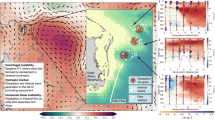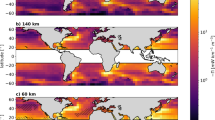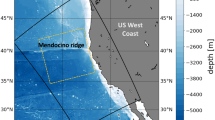Abstract
The ocean circulation is forced at a global scale by winds and fluxes of heat and fresh water. Kinetic energy is dissipated at much smaller scales in the turbulent boundary layers and in the ocean interior1,2, where turbulent mixing controls the transport and storage of tracers such as heat and carbon dioxide3,4. The primary site of wind power input is the Southern Ocean, where the westerly winds are aligned with the Antarctic Circumpolar Current5. The potential energy created here is converted into a vigorous geostrophic eddy field through baroclinic instabilities. The eddy energy can power mixing in the ocean interior6,7,8, but the mechanisms governing energy transfer to the dissipation scale are poorly constrained. Here we present simulations that simultaneously resolve meso- and submeso-scale motions as well as internal waves generated by topography in the Southern Ocean. In our simulations, more than 80% of the wind power input is converted from geostrophic eddies to smaller-scale motions in the abyssal ocean. The conversion is catalysed by rough, small-scale topography. The bulk of the energy is dissipated within the bottom 100 m of the ocean, but about 20% is radiated and dissipated away from topography in the ocean interior, where it can sustain turbulent mixing. We conclude that in the absence of rough topography, the turbulent mixing in the ocean interior would be diminished.
This is a preview of subscription content, access via your institution
Access options
Subscribe to this journal
Receive 12 print issues and online access
$259.00 per year
only $21.58 per issue
Buy this article
- Purchase on Springer Link
- Instant access to full article PDF
Prices may be subject to local taxes which are calculated during checkout





Similar content being viewed by others
References
Wunsch, C. & Ferrari, R. Vertical mixing, energy, and the general circulation of the oceans. Ann. Rev. Fluid Mech. 36, 281–314 (2004).
Hughes, G. O., Hogg, A. & Griffiths, R. W. Available potential energy and irreversible mixing in the meridional overturning circulation. J. Phys. Oceanogr. 39, 3130–3146 (2009).
Sarmiento, J. L. & Toggweiler, J. R. A new model for the role of the oceans in determining atmospheric pCO2 . Nature 308, 621–624 (1984).
Sarmiento, J. L., Gruber, N., Brzezinski, M. A. & Dunne, J. P. High-latitude controls of thermocline nutrients and low latitude biological productivity. Nature 427, 56–60 (2004).
Wunsch, C. The work done by the wind on the oceanic general circulation. J. Phys. Oceanogr. 28, 2331–2339 (1998).
Ferrari, R. & Wunsch, C. Ocean circulation kinetic energy—reservoirs, sources and sinks. Ann. Rev. Fluid Mech. 41, 253–282 (2009).
Naveira Garabato, A., Polzin, K. L., King, B. A., Heywood, K. J. & Visbeck, M. Widespread intense turbulent mixing in the Southern Ocean. Science 303, 210–213 (2004).
Nikurashin, M. & Ferrari, R. Global energy conversion rate from geostrophic flows into internal lee waves in the deep ocean. Geophys. Res. Lett. 38, L08610 (2011).
Charney, J. G. Geostrophic turbulence. J. Atmos. Sci. 28, 1087–1095 (1971).
Vallis, G. K. Atmospheric and Oceanic Fluid Dynamics (Cambridge Univ. Press, 2006).
Hogg, A., Dewar, W., Berloff, P. & Ward, M. Kelvin wave hydraulic control induced by interactions between vortices and topography. J. Fluid Mech. 687, 194–208 (2011).
Zhai, X., Johnson, H. & Marshall, D. Significant sink of ocean-eddy energy near western boundaries. Nature Geosci. 3, 608–612 (2010).
Sen, A., Scott, R. B. & Arbic, B. K. Global energy dissipation rate of deep-ocean low-frequency flows by quadratic bottom boundary layer drag: Computations from current-meter data. Geophys. Res. Lett. 35, L09606 (2008).
Arbic, B. K. et al. Estimates of bottom flows and bottom boundary layer dissipation of the oceanic general circulation from global high-resolution models. J. Geophys. Res. 114, C02024 (2008).
Nikurashin, M. & Ferrari, R. Radiation and dissipation of internal waves generated by geostrophic flows impinging on small-scale topography: Theory. J. Phys. Oceanogr. 40, 1055–1074 (2010).
Nikurashin, M. & Ferrari, R. Radiation and dissipation of internal waves generated by geostrophic flows impinging on small-scale topography: Application to the Southern Ocean. J. Phys. Oceanogr. 40, 2025–2042 (2010).
Ferrari, R. A frontal challenge for climate models. Science 332, 316–317 (2011).
Molemaker, M. J., McWilliams, J. C & Capet, X. Balanced and unbalanced routes to dissipation in an equilibrated Eady flow. J. Fluid Mech. 654, 35–63 (2010).
Polzin, K. L., Toole, J. M., Ledwell, J. R. & Schmitt, R. W. Spatial variability of turbulent mixing in the abyssal ocean. Science 276, 93–96 (1997).
Ledwell, J. R. et al. Evidence for enhanced mixing over rough topography. Nature 403, 179–182 (2000).
Heywood, K. J., Naveira Garabato, A. C. & Stevens, D. P. High mixing rates in the abyssal Southern Ocean. Nature 415, 1011–1014 (2002).
Winters, K. B., Lombard, P. N., Riley, J. J. & DÁsaro, E. A. Available potential energy and mixing in density-stratified fluids. J. Fluid Mech. 289, 115–128 (1995).
Ilicak, M., Adcroft, A. J., Griffies, S. M. & Hallberg, R. W. Spurious dianeutral mixing and the role of momentum closure. Ocean Model. 45–46 (2012).
Stammer, D. Global characteristics of ocean variability estimated from regional TOPEX/POSEIDON altimeter measurements. J. Phys. Oceanogr. 27, 1743–1769 (1997).
Stammer, D. On eddy characteristics, eddy transports, and mean flow properties. J. Phys. Oceanogr. 28, 727–739 (1998).
Ozgokmen, T. M., Poje, A. C., Fischer, P. F. & Haza, A. C. Large eddy simulations of mixed layer instabilities and sampling strategies. Ocean Model. 39, 311–331 (2011).
Marshall, J., Adcroft, A. J., Hill, C., Perelman, L. & Heisey, C. A finite-volume, incompressible (Navier–Stokes) model for studies of the ocean on parallel computers. J. Geophys. Res. 102, 5753–5766 (1997).
Acknowledgements
The authors thank I. Held and A. Hogg for very useful comments on the manuscript. The work was financially supported by the NSF through award OCE-1027603. Simulations were performed using GFDL’s supercomputer facility.
Author information
Authors and Affiliations
Contributions
M.N. performed the numerical experiments and led the analysis of the results and writing of the paper. M.N. and G.K.V. were responsible for the overall design of the experiments, interpretation of the results and writing of the paper. A.A. contributed to the design of the experiments and the interpretation of the results.
Corresponding author
Ethics declarations
Competing interests
The authors declare no competing financial interests.
Rights and permissions
About this article
Cite this article
Nikurashin, M., Vallis, G. & Adcroft, A. Routes to energy dissipation for geostrophic flows in the Southern Ocean. Nature Geosci 6, 48–51 (2013). https://doi.org/10.1038/ngeo1657
Received:
Accepted:
Published:
Issue Date:
DOI: https://doi.org/10.1038/ngeo1657
This article is cited by
-
Submesoscale variability on the edge of Kuroshio-shed eddy in the northern South China Sea observed by underwater gliders
Ocean Dynamics (2024)
-
Dissipation of mesoscale eddies at a western boundary via a direct energy cascade
Scientific Reports (2022)
-
The characteristics of spontaneous near-inertial wave generation from an anticyclonic mesoscale eddy
Journal of Oceanology and Limnology (2022)
-
Dissipation of mesoscale eddies and its contribution to mixing in the northern South China Sea
Scientific Reports (2019)
-
Spatial and seasonal variability of global ocean diapycnal transport inferred from Argo profiles
Journal of Oceanology and Limnology (2019)



